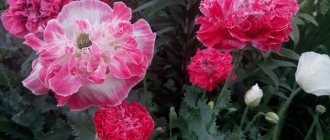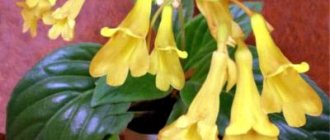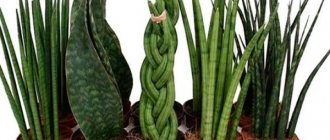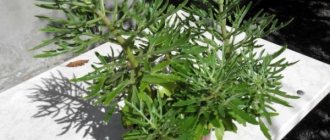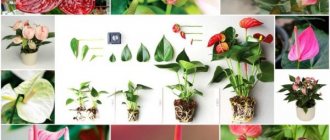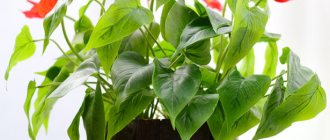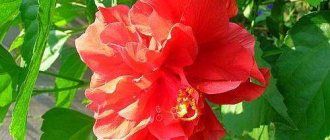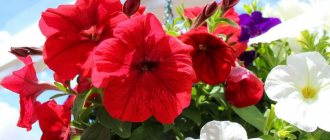Dahlias Gallery or Gallery are a new subspecies of a popular plant, familiar to many from early childhood. Unpretentious in care, even novice gardeners can grow plants of this type; almost all shades are found in the description of varieties, except blue. It differs from the usual bushes in its short stature, early flowering and lush double flowers. Brought out by a Dutch breeder as a border option for decorating flower beds, garden paths, and patios.
When growing dahlia Gallery and in the process of caring for them, you should remember that the plant comes from Mexico, so it loves the sun. In the descriptions of this variety collection, experienced flower growers indicate that the bushes can delight the eye with a variety of pastel and bright colors not only outdoors - they bloom beautifully indoors and in winter gardens. At the same time, Gallery plants are bouquet plants that do well when cut.
Features of planting the variety
If all conditions are met, the plant rarely grows above 40 cm. It is better to plant it for permanent residence from seedlings.
Seeds must be purchased from a trusted supplier and planted in pots or disposable cups with a good bottom layer of expanded clay or fine gravel - plants do not tolerate excess moisture well. It is important to remember: Dahlia Gallery is a hybrid variety, so growing beautiful, full, double flowers from home-produced seeds is unlikely to work.
Without special treatment, plants in the next generation lose their decorative qualities. The main soil for good flower development is a mixture of peat, humus and sand for open ground. It can also be used when planting in containers or large pots. Or you can buy a ready-made composition, always labeled “For flowers and flowering plants.”
The process of planting Gallery seeds is no different from similar manipulations with ordinary annuals:
- Place seeds on moist soil at some distance from each other or 2-3 seeds in disposable containers for seedlings.
- Sprinkle a centimeter layer of substrate on top.
- Cover the entire structure with film.
- It should be kept in a room with an air temperature of at least 27 degrees.
- As soon as the seedlings begin to hatch, remove the cover and continue caring for ordinary seedlings of garden crops.
Important: Gallery dahlias should be watered only with a spray bottle so that the soil is moist but not wet.
Seedlings can be planted for permanent residence only when frost cannot return. If by this time the plants have grown enough, but they cannot be planted in a flowerbed due to bad weather, you will have to pluck the plants. For good development and early flowering, they need more space than in a seedling container.
Before picking, be sure to fill the containers with the borings with warm water for several hours in order to injure the plants as little as possible during planting. If you plan to grow flowers in containers or large flower pots for decorating a balcony, picking can be combined with planting for a permanent “place of residence.” In this case, you need to add a little wood ash to the soil after disinfecting the soil with a thick solution of potassium permanganate heated to 70 degrees. Containers for decorating a garden or flower bed with such Dutch beauties should be wide - at least 30 cm wide and the same depth.
A week or two before the planned transfer of dahlias outside, pots with plants or seedlings should be gradually taken out into the open air for hardening. Gradually, the time the Gallery spends outside should be increased so that the flowers get used to the fresh air. At the same time, they reduce the temperature in the room where the plants grew by 1-2 degrees every other day.
Varieties
Now the company is the originator of Gebr. Verwer offers 25 varieties of low-growing dahlias in rich and pastel, harmonious shades. The most popular varieties and characteristics of the inflorescences are named here.
Dahlias Gallery Art Deco
Up to 25 flowers are formed on compact bushes. Bright red-orange color of reed flowers. The graceful curves of the petals create a gentle shimmer of the main shade.
Georgina Gallery Art Nouveau
The flowers are light purple or dark pink. The edges deviate in one direction, creating an original graphic design.
Georgina Gallery Art Fair
The pure white color of the reed petals in the center of the 15-cm basket turns into a soft light green shade. All petals are smoothly curved downwards.
Dahlias Gallery Bellini
The bright pink shade of the reed flowers becomes a light creamy pink towards the center of the basket. Inflorescences are 13-14 cm wide.
Georgina Gallery Valentine
The baskets are distinguished by an intense red tint over the entire surface, except for the lower petals, which have faint undertones transitioning to orange. The tips of the petals bend towards the base, giving the inflorescence the appearance of a hemisphere.
Dahlias Gallery Singer
The diameter of the inflorescences with the classic shape characteristic of dahlias is up to 13 cm. The color is rich red without halftones.
Dahlia Gallery Cobra
The variety is distinguished by a pure orange shade of low intensity. Reed flowers smoothly bend in different directions.
Georgina Gallery La Tour
The delicate pink tone of the petals along the edges of the basket turns into a more saturated shade of lilac. This feature is clearly observed in the center of the inflorescence. Newly opened flowers at the base with a soft lemon undertone.
Dahlia Gallery Leonardo
Very original graphics of reed flowers in a basket of a pleasant salmon shade. Each petal has a raised midline, and the longitudinal edges are lowered. The ends also curl upward.
Dahlia Gallery Matisse
The orange color of the petals is diluted with yellowish longitudinal stripes. Towards the center of the basket the yellow becomes more intense.
Dahlias Gallery of Coins
The warm milky white shade turns into an unobtrusive lilac tone towards the edge of the petals. The base is soft yellowish in color.
Dahlias Gallery Pablo
The petals, yellow at the base and in the middle, soar upward, forming a lush basket. Each petal is edged with a delicate salmon pink hue.
Dahlias Gallery Rembrandt
Pure pink hue of wide reed flowers. The basket is lush, up to 13 cm in diameter.
Dahlia Gallery Salvador
Delicate pink petals are covered with thin longitudinal strokes of a more saturated shade. The basket is very lush.
Place for planting dahlia Gallery
Flowers of this species love light, but in extreme heat the soil under the bush dries out quickly, so you should choose sunny areas with sufficient lighting for 6-8 hours. You can choose such a place experimentally - determine in which part of your plot sunlight will fall on the plants for exactly the same amount of time. Since the varieties in the collection do not contain blue, bright plants of all shades of blue and conifers will be good neighbors for colorful variety in the flowerbed. The only thing the dahlia doesn't like is asters - if such a flower grows nearby, or if it was at the site where Gallery was planted, the plant will die.
The Dutch “babies” do not tolerate drafts, northern, gusty winds well, which must be taken into account when choosing a planting site.
Description and characteristics of the Dahlia Gallery flower
It took a passionate and persistent breeder from the Netherlands, G. Verver, fifteen long years to obtain a truly unique collection of new generation dahlias.
The variety series was born in 1999, it received the beautiful name Gallery. The collection includes about twenty varieties, which differ in color, shape and diameter of the flower.
Double and semi-double, scarlet, purple, white and pink, peach and other shades - thanks to nature and the talent of the breeder, it was possible to create real beauty. And what is very important is that all these plants are easy to care for.
The creation of lines of low-growing varieties is one of the main directions in modern dahlia breeding. Priority is given to:
- compactness of plants;
- beautiful habit;
- the possibility is dispensed with when grown without plant supports;
- small height;
- beautiful flowering.
The Gallery series fully meets such requests. Their bushes are small in size, have lush, beautiful greenery, and dense flower stalks. The height of the plants is 30-45 cm, so they are great for borders (foreground) in pots, on loggias, balconies, and patios.
Numerous inflorescences form on the compact bushes of these dahlias. Their average diameter is from 10 to 15 cm. The flowering period is long and with proper care, as well as early growing of divisions, dahlias will bloom from the end of May to mid-September (provided there is a warm autumn).
Flowering is abundant and continuous. The borders where these dahlias are planted immediately attract attention with the originality of the flowers and their special beauty. Low-growing Gallery varieties are suitable for growing in pots, various flower pots, and containers. This allows you to transfer them to any area of the site, to use both single-type plantings (“bright spot”) and in groups.
Such dahlias will decorate a veranda, loggia, balcony, and will be appropriate for decorating some not particularly attractive places on the site. They are also suitable for cutting; they remain fresh for up to 6-7 days.
Planting dahlia Gallery in open ground
In the flower bed prepared in the fall, make a hole that is 3 times larger than the size of the root system of the plant or its tubers. Seedlings should be immersed in the soil until the first true leaves, tubers - 2 cm above the root collar. During the planting process, you can feed the bush with a small amount of humus or wood ash.
Important: you cannot use all types of manure and nitrogen fertilizers to feed dahlia Gallery - an excess of this mineral fertilizer leads to the overgrowth of miniature bushes and a reduction in flowering time.
The soil around the plant cannot be compacted too much - dahlia roots love air. Water and cover with a small layer of mulch - this way the soil will not dry out and weeds will not bother you. Mulching will also help control slugs and insect pests.
If the weather forecast warns of cold weather, you should cover the bushes with glass jars at night. All types of cover can be used except fabric.
Care
The plants are not difficult to care for, but they do require some attention.
- Proper cultivation of dahlia Gallery involves moderate watering. A drainage layer is placed at the bottom of the tubs.
- It is convenient to use fertilizers along with watering. For potted plants, the best option is special flower fertilizers. In the flowerbed, dahlias are fertilized with humus, wood ash, and superphosphate.
- An important point in plant care is pinching. It is recommended to leave only 2-3 shoots, which will form fairly large inflorescences. If pinching is not carried out, the bush will be thickened and will not please with lush flowering.
For the winter, the tubers are dug up and stored in containers with sand in the basement. In apartment conditions, small nodules are placed in the refrigerator.
With proper care, dahlias are not affected by diseases and pests. Plants in this series will create a cozy corner for relaxation even on a small balcony or in the yard.
Watering and fertilizing
It is best to apply special fertilizers for flowering plants - they have a prolonged effect and will not allow the hybrid to grow larger than the required size or deform the flowers. You should also be careful with watering - dahlias do not like too wet soil and do not tolerate too dry soil. It’s worth being guided by the weather.
It is also not worth overfeeding the plants - a few feedings per season are enough for the plants to delight with bright, lush flowers until frost.
It is important to know: if Gallery dahlias have grown too much even before flowering, you should stop watering and fertilizing.
Application in design
Gallery dahlias are planted to border borders, flower beds with low-growing plants, on balconies and terraces. All plants from the series are elegant and decorative. It is not for nothing that the author gave most of the dahlias the names of famous artists who forced society to take a fresh look at art. Flowers located in the foreground of buildings are especially expressive and picturesque. The monochrome of the walls emphasizes the graphics of the leaves and the purity of the colors of the petals. Flowers are also suitable for growing indoors. They last for almost a week when cut.
Cleaning and storage
Low-growing varieties of this plant produce tubers that are too small to be stored like the rhizomes of regular, tall varieties. They will have to be removed for storage in several stages:
- Watering and fertilizing should be stopped 1-2 weeks in advance. So that there is less moisture in the neck of the tuber.
- Carefully dig up the nodules, discarding any that have spots of unknown origin.
- Leave the crop in the shade so that the neck of the tuber wilts slightly.
- Rinse all the tubers under running water and let them dry naturally.
- Clean the tubers from suction roots and sprouts.
- Dilute any systemic fungicide in water, immerse planting material in it for 15 minutes, remove and dry on paper.
- After a day, put the dahlia Gallery tubers into bags or containers with coarse vermiculite and send for storage. The optimal air temperature in the basement or cellar with planting material should not exceed +8 degrees.
You can store the tubers in sand or large sawdust, but then you will have to reconsider the rhizomes from time to time - if there is too much water in the air, they can germinate ahead of time, and if they are dry, they can dry out and die.
Description of the plant
The dahlia grows in the form of a bush, which is low-growing, lush and branched. The plant is characterized by the presence of hollow stems, the height of which is 40 centimeters. The flower has a large number of dark green leaves. Dahlia blooms in red. Double flowers have slightly yellow roots. The flowers can reach 15 centimeters in diameter.
The plant has beautiful flowers with flat petals. They are characterized by twisting and bending slightly towards the stem.
The flower can reach 35-40 centimeters in height, which allows it to be used as borders. In autumn, long and abundant flowering is observed. Due to their attractive appearance, dahlias are used to decorate terraces, verandas and balconies. Dahlia is a very beautiful plant, which is why many gardeners prefer it.
Storage
After digging flower tubers from the ground, they should be stored in a dry place at a temperature of + three ... + five degrees. A good place for this is the basement, where air circulates. Tubers are well preserved in a box with pine needles, peat or sand. It is also possible to lay the tubers on peat and sprinkle with sawdust or sand.
Drying the tubers is key, otherwise they will rot. If there are various damages, the tubers are trimmed and the cut areas are sprinkled with charcoal.
It is also worth making sure that the tubers do not dry out. Otherwise, they may produce weak shoots. When dry, the tubers are moistened. If there is no ventilation in the basement, you need to use a fan, turn it on for 30 minutes 3 times a week.
If there is no basement or cellar, dahlias can be stored in the apartment. To do this, they must be placed in a cool place. such a place could be a loggia or balcony. In this case, the tubers can be hidden in a bag with sawdust, dry peat, or tied well with sand.
Benefits of the flower
The undeniable advantage of the dahlia is that it is not demanding on growing conditions. The plant can be grown not only in the sun, but also in the shade. Lighting features do not affect the flowering of the variety. If there is a need for long-term flowering of dahlias, it is recommended to plant them in partial shade.
During the flower growing period, it is recommended to maintain a moderate level of humidity. Since the tubers of the plant can rot, they are not planted in lowlands. To avoid this problem, it is necessary to organize drainage before planting the crop. Expanded clay or broken brick can be used for this purpose.
Dahlias can fully take root in various types of soil. That is why they are allowed to be planted not only in black soil, but also in loamy and sandy soils. Due to the undemanding nature of dahlias regarding growing conditions, they can be planted in any place convenient for humans.
Cleaning dahlias
Dahlias must be harvested after the start of frost. This often falls in the second half of October. A few days before this, it is necessary to trim off the remaining leaves and stems. To prevent moisture from entering, the stems can be wrapped in aluminum foil. It is better to dig up tubers early in the morning and in dry weather for better drying. In addition, soil residues are better removed from dried tubers.
Before digging up the tubers, the plant must be dug within a radius of 30 cm from the stem. Cut off the supply roots, clean the tubers from the soil or rinse them with water for better drying, it is better to turn them over.

